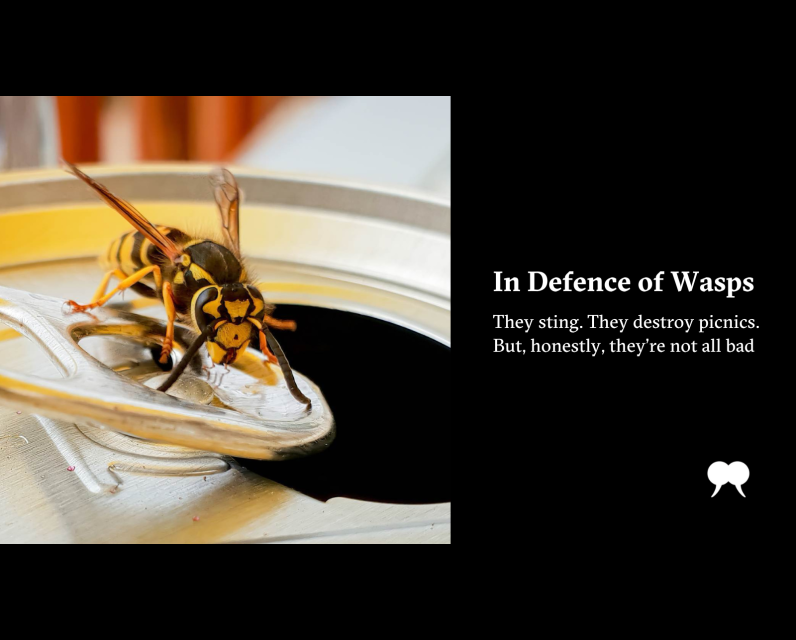In Defence of Wasps

It feels like a cruel irony: at the height of the insect apocalypse, as butterflies and bees and countless more bugs around the world die off, wasps are mostly doing just fine. In fact, they’re absolutely thriving. Several studies from recent years suggest this heat-loving insect is expanding its footprint across Europe and North America. Of all the creatures to win the climate lottery.
Among those distraught by this development is my daughter. She’s as big a fan of the outdoors as you’d expect a nine-year-old to be, but the usual exceptions apply: sharks, spiders, snakes. Wasps are the worst; they’re the only ones that have actually hurt her.
I should clarify that, by “wasps,” I mean the human-stinging variety we also call “yellowjackets” and “hornets.” Both of those names actually encompass a number of similar-looking species, but altogether, the stinging demons that swarm our picnics comprise a tiny percentage of the world’s thousands of wasp species, the great majority of which do not sting people. Many can’t even sting. Some are too tiny for us to notice; the body length of a “fairy wasp,” the world’s smallest known insect, is a tenth of a millimetre, roughly the width of a human hair.
The yellowjacket variety—the creature you think of when you hear “wasp”—may hurt us from time to time, but they could be a great deal worse. If you want a real horror show, look up the parasitic kind of wasps. Those are the ones that lay their eggs inside live caterpillars and other creatures. When the eggs hatch, the tiny wasp larvae eat their hosts alive from the inside out. This discovery so disturbed Charles Darwin that it made him question his belief in God; it also inspired the “chest burster” scene from Alien.
I haven’t tried consoling my daughter with this information. She’s still traumatized by the double sting she received on the tip of her index finger three years ago. A Canadian rite of passage: we were grazing our way down an alleyway lined with berry bushes and fruit trees, beneath a blazing August sun. Everything was going great until she plucked the wrong raspberry.
After the tears subsided, I assumed that eventually the terror would too. Instead, the opposite happened. For three summers now, her fear of wasps has only grown. She flinches at the sight of one. If two or more appear, pandemonium ensues. She runs, screams if we try to stop her, and that’s the end of the party. Last summer, I bought her one of those electric rackets for a camping trip; she became a genocidaire. This seemed to mark a turning point, and I was briefly proud of us both—of her for confronting the enemy, and of myself for handing her the weapon. Mission accomplished, I smugly thought.
Nope. This summer, after a slow start to wasp season in Vancouver, we went out for a beach picnic—unarmed. When the yellowjackets showed up, my daughter panicked and bolted. We went home early, struggling with a range of emotions: parental concern, compassion, annoyance. I don’t want my daughter to suffer; I don’t want my own party ruined by irrational phobias; I dislike my petty reaction; I’m frustrated by my inability to help my daughter overcome her phobia. For her, there’s nothing complicated about it. Wasps sting, it hurts, run.
Where there is suffering, there are lessons. Our fears, our enemies, our triggers—they all have something to teach us. This isn’t just about me and my daughter. Everyone hates wasps.
Everyone, that is, except for entomologists. It was Katie Marshall, an entomologist and associate professor at the University of British Columbia, who helped me see the world through the eyes of a wasp. One morning shortly after my kid’s latest panic attack, I emailed Marshall about my daughter’s situation. She’d heard this story before and told me to give her a call.
“That ability to sting is really a defensive mechanism in this cruel world,” Marshall told me. “Imagine there’s this giant that’s like 100 times bigger than you, and it’s swatting you.” Wasps may be excellent predators, she explained, but they are nowhere near the top of the food chain. They’re predated upon, by birds especially, but also other insects that eat their larvae—their children!—or trap the parents in webs. When they sting us, it’s because they’re feeling threatened.
I can think of one or two fights I’ve had with loved ones that correspond to this dynamic. So do many of the political conflicts that define this historical moment, an analogy Marshall brought up without any prompting from me. “Think about how Canadians feel, for instance, compared to Americans,” she said. “We see this big powerful nation. What might be a joke for them is really not a joke for us, when it comes to thinking about our sovereignty.”
I pictured 41 million Canadians as wasps, grazing on the American picnic. We, too, have children to feed. We wouldn’t sting our massive neighbour unprovoked, but once it starts swatting us, once it corners us?
Marshall quickly brought the conversation back to biology and ecosystems. Wasps embody all kinds of evolutionary marvels—from metamorphosis, “an extreme form of puberty,” to the eusociality some share with bees and ants, whose hives and colonies can be understood as a single “superorganism.”
Marshall gently critiqued the human tendency to weigh the value of a species by their utility to us. But if you’re wondering what wasps are good for, the list is long. They’re pollinators—often not so prolific as their bee cousins, lacking hair to capture pollen, but they’ve evolved intricate symbiotic relationships with countless species of plants and animals: “no wasps, no figs,” as Marshall put it.
Wasps are excellent predators of the tiny bugs that eat our crops (aphids) and forests (caterpillars). They help control invasive species. In fact, the Canadian Food Inspection Agency has approved the mass breeding and deployment of four wasp species as “biological control agents” to combat the emerald ash borer, an Asian beetle that is destroying ash forests around the country.
As scavengers, wasps also tidy up the world by clearing the flesh off dead animals to feed their young. Adult wasps mostly eat liquid food—which is why they love your watermelon and your Pinot Gris; the bits of burger they steal are for their prepubescent larvae.
Even the worst part of wasps—their venom—has an astonishing range of uses beyond inflicting pain, terror, and life-threatening anaphylactic shock on 1 percent of the population. In China, wasp venom has been used for centuries to treat arthritis; more recently, scientists have learned to separate anti-inflammatory compounds out of the venom, discovering many other uses in the process—as anti-coagulants, immunosuppressants, and more. “Wasp venom,” wrote the authors of one paper, “exhibited various pharmacological effects in the treatment of pain, inflammatory disease, and neurodegenerative diseases.”
Here’s another terrible/wonderful thing about wasps: they communicate by pheromone, and if one feels threatened, they spread a chemical alarm through the air that stirs their brethren into battle mode. There’s another side to that: If you don’t want to get stung, stay calm. Let them inspect you. Don’t freak out. They’ll fly on. Ignore them and they’ll ignore you; panic and they’ll panic too.
None of this helps my daughter. It doesn’t do much for our picnics either, nor for the patrons and proprietors of restaurant patios in late summer. When I asked Marshall what she does to ward off the sharp end of a hornet, she suggested a practical solution: fake wasp nests, easily crafted or purchased on the internet. Wasps are highly territorial, and apparently more frightened of each other than they are of us.
Can’t we just kill them? I asked. Not all of them. Just the ones in earshot.
Marshall didn’t endorse this solution, but she didn’t condemn it either. I took that as tacit approval. Right after we spoke, I put a fresh pair of batteries in my daughter’s electric racket and rearmed her. Her eyes lit up. Perhaps, I thought, she just needs to kill a few more.
Co-operation and harmony are fine ideals to live by. But violence is part of nature too. Of all the lessons wasps offer, the one my child can act on turns out to be one humans have long been aware of: the best defence is a good offence.
With thanks to the Trottier Foundation for helping The Walrus publish writing on climate change and the environment.
The post In Defence of Wasps first appeared on The Walrus.

Comments
Be the first to comment